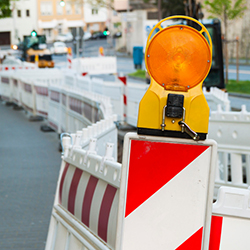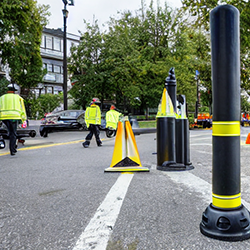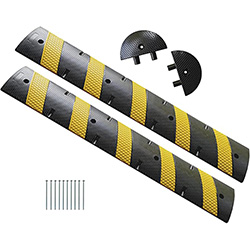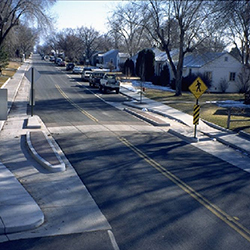The Science Behind Speed Bumps and Road Safety
Speed bumps are an essential feature of road infrastructure designed to slow down vehicles and improve road safety. They are commonly found in urban areas, especially in cities like Seattle where traffic congestion and speeding are major concerns. The main purpose of speed bumps is to force drivers to reduce their speed, preventing accidents and promoting safer driving habits. By creating a physical barrier on the road, speed bumps effectively slow down vehicles, giving pedestrians and other road users a safer environment to navigate. In Seattle, the implementation of speed bumps has been successful in reducing speeding incidents and enhancing overall road safety.
Purpose of speed bumps
The purpose of speed bumps is to slow down vehicles and improve road safety. Speed bumps are commonly used in residential areas and parking lots to encourage drivers to reduce their speed. By forcing drivers to slow down, speed bumps help create a safer environment for pedestrians, cyclists, and other road users. Additionally, speed bumps are an effective tool for creating livable streets, as they promote a sense of community and encourage active transportation. Livable streets are designed to prioritize the needs of pedestrians and cyclists, making them more accessible and enjoyable for everyone. By incorporating speed bumps into road design, cities can enhance road safety and create a more livable environment.Importance of road safety
Road safety is of utmost importance in ensuring the well-being of both pedestrians and drivers. One of the most effective traffic calming techniques used to enhance road safety is the installation of speed bumps. Speed bumps are designed to reduce the speed of vehicles and force drivers to slow down, thereby minimizing the risk of accidents. These raised portions of the road are strategically placed in areas where speeding is a concern, such as residential neighborhoods, school zones, and parking lots. By implementing speed bumps, authorities can effectively control and regulate the flow of traffic, making the roads safer for everyone. The use of speed bumps as a traffic calming technique has proven to be highly effective in reducing accidents and promoting road safety.The Science Behind Speed Bumps
Physics of speed bumps
Speed bumps are a common feature on many roads and parking lots, designed to slow down vehicles and improve road safety. The physics behind speed bumps is based on the principle of inertia. When a vehicle approaches a speed bump, its inertia causes it to resist changes in motion. As the vehicle travels over the bump, its wheels experience a sudden change in elevation, resulting in a jolt or bounce. This jolt is felt by the occupants of the vehicle and serves as a reminder to reduce speed. The height and shape of speed bumps are carefully designed to maximize their effectiveness in slowing down vehicles without causing damage. By understanding the physics of speed bumps, engineers can create road features that help promote safer driving.Impact on vehicle speed
Speed humps are an effective traffic calming measure that helps to reduce vehicle speed in residential areas. These raised platforms are strategically placed along the road to create a physical barrier, forcing drivers to slow down. Studies have shown that speed humps can significantly decrease the average vehicle speed, improving road safety for both motorists and pedestrians. By introducing these traffic calming devices, communities can create a safer environment and reduce the risk of accidents caused by excessive speed.Effect on driver behavior
Speed bumps have a significant effect on driver behavior, particularly in the city of Jacksonville. These physical traffic calming measures are designed to slow down vehicles and improve road safety. Studies have shown that speed bumps can reduce vehicle speeds and discourage reckless driving. In Jacksonville, the presence of speed bumps has been effective in reducing accidents and promoting responsible driving. Drivers are more cautious when approaching speed bumps, as they are aware of the potential damage to their vehicles and the risk of injury. The implementation of speed bumps in Jacksonville has contributed to a safer and more regulated traffic environment.Design and Placement of Speed Bumps
Types of speed bumps
There are several types of speed bumps that are commonly used to control the speed of vehicles on roads. One type is the traditional speed bump, which is a raised portion of the road surface that forces drivers to slow down. Another type is the speed hump, which is a longer and flatter version of the speed bump. Speed humps are designed to be less jarring to vehicles and provide a smoother ride. A third type is the speed cushion, which is a series of raised sections that are spaced apart to allow larger vehicles, such as buses and emergency vehicles, to straddle them without slowing down. Each type of speed bump has its own advantages and disadvantages, and the choice of which type to use depends on factors such as the speed limit of the road and the volume of traffic.Factors to consider in design
When designing speed bumps, there are several factors that need to be considered. One important factor is the use of cord protectors. Cord protectors are essential in preventing damage to underground cables and wires. They ensure that the cables are protected from excessive pressure and potential breakage. By incorporating cord protectors into the design of speed bumps, the risk of accidents caused by damaged cables can be minimized. Additionally, cord protectors also help in organizing and managing the cables, making maintenance and repairs easier. Therefore, it is crucial to include cord protectors as a key consideration in the design of speed bumps.Proper placement for maximum effectiveness
Proper placement of speed bumps is crucial for maximizing their effectiveness in ensuring road safety. By strategically positioning speed bumps in areas with high traffic flow and near pedestrian crossings, they serve as effective traffic calming measures. One of the advantages of placing speed bumps in these locations is the reduction of vehicle speeds, which in turn decreases the likelihood of accidents. Additionally, speed bumps placed near schools and residential areas contribute to creating safer environments for children and residents. The proper placement of speed bumps plays a significant role in promoting road safety and reducing the risk of accidents.Benefits of Speed Bumps
Reduced vehicle speed
Reduced vehicle speed is one of the key benefits of installing speed breakers. Speed breakers are designed to slow down vehicles and force drivers to reduce their speed. By implementing speed breakers, the risk of accidents and collisions can be significantly reduced. Studies have shown that speed breakers can effectively decrease the average speed of vehicles in residential areas, school zones, and other high-risk areas. This reduction in speed enhances road safety by giving drivers more time to react to unexpected situations and preventing excessive speeding. Installing speed breakers is an important measure in promoting safer roads and protecting pedestrians and other road users.Enhanced pedestrian safety
Enhanced pedestrian safety is a crucial aspect of road design and traffic management. Speed bumps play a significant role in ensuring the safety of pedestrians by reducing vehicle speed and encouraging drivers to be more cautious. These raised structures are strategically placed in areas with high pedestrian activity, such as residential neighborhoods, school zones, and shopping centers. By forcing drivers to slow down, speed bumps provide pedestrians with a safer environment to cross the road or walk alongside it. Moreover, the presence of speed bumps serves as a visual reminder for drivers to be vigilant and aware of their surroundings, especially in areas where children or elderly individuals may be present. Overall, the incorporation of speed bumps in road design is an effective measure to enhance pedestrian safety and minimize the risk of accidents.Prevention of accidents
Prevention of accidents is a crucial aspect of road safety. Speed bumps play a significant role in reducing the occurrence of accidents by effectively slowing down vehicles. These raised structures are strategically placed on roads to force drivers to reduce their speed, especially in areas where there is a high risk of accidents. By creating a physical barrier, speed bumps encourage drivers to be more cautious and attentive, ultimately preventing collisions and protecting pedestrians and other road users. Additionally, speed bumps serve as a visual reminder for drivers to adhere to speed limits and promote safer driving habits. Their presence acts as a deterrent, discouraging reckless driving and promoting responsible behavior on the road. Overall, the implementation of speed bumps is an effective measure in the prevention of accidents and the promotion of road safety.Challenges and Limitations of Speed Bumps
Impact on emergency vehicles
Speed bumps are an effective way to reduce vehicle speeds and improve road safety. However, they can have a significant impact on emergency vehicles. When responding to emergencies, every second counts, and speed bumps can slow down the response time of ambulances, fire trucks, and police cars. The jolts and vibrations caused by speed bumps can also affect the stability of emergency vehicles, potentially compromising the safety of both the occupants and the patients. It is crucial to strike a balance between road safety and the needs of emergency services to ensure timely and efficient emergency response.Discomfort for drivers
Speed bumps are a common traffic calming measure used to reduce vehicle speeds in residential areas and near schools. While they are effective in slowing down traffic, speed bumps can cause significant discomfort for drivers. The sudden jolts and vibrations experienced when driving over speed bumps can lead to back and neck pain, vehicle damage, and increased wear and tear on suspension systems. Despite the discomfort, speed bumps play a crucial role in improving road safety by reducing liability for accidents and encouraging drivers to adhere to speed limits. By creating a physical barrier that forces drivers to slow down, speed bumps help prevent speeding-related accidents and protect pedestrians and other road users. Therefore, although drivers may find them uncomfortable, speed bumps are an essential tool in promoting safer roads and reducing the risk of accidents.Maintenance and cost considerations
Maintenance and cost considerations are crucial when it comes to implementing speed bumps on roads. One important factor to consider is the use of modular speed bumps. These speed bumps are designed to be easily installed and removed, making maintenance tasks more efficient and cost-effective. Additionally, modular speed bumps can be customized to fit different road conditions and requirements. This flexibility allows for easy adjustments and modifications as needed. Another cost consideration is the durability of the speed bumps. Investing in high-quality materials ensures that the speed bumps have a longer lifespan, reducing the need for frequent replacements and repairs. By carefully considering the maintenance and cost aspects, road authorities can implement effective and sustainable speed bump solutions.Conclusion
Summary of key points
Speed bumps are an effective traffic calming measure that can significantly improve road safety. They are designed to slow down vehicles and reduce the risk of accidents, especially in areas with high pedestrian activity or near schools. The main purpose of speed bumps is to force drivers to reduce their speed, making it safer for pedestrians to cross the road. Studies have shown that the presence of speed bumps can lead to a decrease in speeding and a reduction in the number of accidents. Additionally, speed bumps can also help to reduce noise pollution and improve the overall quality of life in residential areas. Overall, speed bumps play a crucial role in enhancing road safety and creating safer environments for pedestrians and drivers alike.Importance of balancing road safety and convenience
Balancing road safety and convenience is of utmost importance when it comes to designing and implementing speed bumps. Speed bumps are an effective tool for controlling vehicle speed and reducing accidents. However, they can also cause inconvenience to drivers and passengers, especially if they are too high or placed inappropriately. Therefore, it is crucial to strike a balance between ensuring road safety and minimizing disruption to the flow of traffic. By considering factors such as the location, design, and height of speed bumps, authorities can create a safer road environment without compromising on convenience.Future developments in speed bump technology
Future developments in speed bump technology are focused on improving their effectiveness and reducing their impact on vehicles. One potential development is the use of smart speed bumps that can detect the speed of approaching vehicles and adjust their height accordingly. This technology would allow speed bumps to be more effective in slowing down speeding vehicles while minimizing the discomfort experienced by drivers. Another development is the use of materials that are more durable and resistant to wear and tear. This would extend the lifespan of speed bumps and reduce the need for frequent repairs and replacements. Additionally, researchers are exploring the use of speed bumps that generate electricity from the kinetic energy of passing vehicles. This renewable energy source could be used to power nearby streetlights or other infrastructure, making speed bumps not only a safety measure but also a sustainable solution.Exploring the Evolution of Speed Bumps
Speed bumps are a common feature on roads and parking lots, designed to slow down vehicles and improve safety. They are typically made of asphalt or concrete and are strategically placed in areas where speeding is a concern. The purpose of speed bumps is to force drivers to reduce their speed, preventing accidents and promoting a safer environment for pedestrians and other road users. These raised obstacles can vary in size and shape, but they all serve the same purpose: to slow down vehicles. Speed bumps have evolved over time, with new designs and materials being introduced to enhance their effectiveness. In this article, we will explore the evolution of speed bumps and the impact they have had on road safety.





